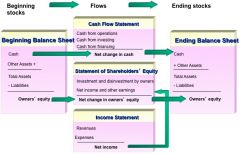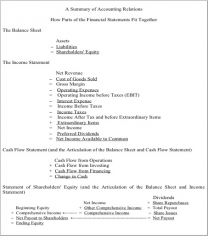![]()
![]()
![]()
Use LEFT and RIGHT arrow keys to navigate between flashcards;
Use UP and DOWN arrow keys to flip the card;
H to show hint;
A reads text to speech;
40 Cards in this Set
- Front
- Back
|
Accounting Relation
|
An equation that expresses components of financial statements in terms of other components. 33
|
|
|
Articulation
|
The way that financial statements relate to each other. 40
|
|
|
Asset
|
An investment that is expected to produce future payoffs. 34
|
|
|
Capital Gain
|
The amount by which the price of an investment changes. 46
|
|
|
Comprehensive Income
|
The total income reported (in the income statement and elsewhere in the financial statements). 39
|
|
|
Conservative Accounting
|
The practice of recording relatively low values for net assets on the balance sheets, or omitting assets altogether. 50
|
|
|
Dirty Surplus Accounting
|
Accounting that books income in the equity statement rather than the income statement. 39
|
|
|
Expense
|
A value given up in earning revenue that is recognized in the financial statements. 34
|
|
|
Fair Value
|
The term that accountants use for the value of an asset or liability. This terms means the market value, or an estimate of market value when a liquid market does not exist. 44
|
|
|
Flows
|
Changes in stocks between two points in time in financial statements. Compare with stocks. 40
|
|
|
Historical Cost Accounting
|
Records assets and liabilities at their historical cost, then (in most cases) amortizes the cost over periods to the income statement. 44
|
|
|
Intangible Asset
|
An asset without physical form. 45
|
|
|
Liability
|
A claim on payoffs from the firm other than by the owners. 34
|
|
|
Mark-to-market Accounting
|
Records assets and liabilities at their market value. 44
|
|
|
Market value added
|
The amount by which shareholder wealth increases in the market, plus any dividend received. It is equal to the stock return. 46
|
|
|
Matching Principle
|
The accounting principle by which expenses are matched with the revenues for which they are incurred. 46
|
|
|
Net Payout
|
Cash distributed to shareholders. 39
|
|
|
Reliability Criterion
|
The accounting principle that requires assets, liabilities, revenues, and expenses to be booked only if they can be measured with reasonable precision based on objective evidence. 49
|
|
|
Revenue
|
Value received from customers that is recognized in the financial statements. 34
|
|
|
Revenue recognition principle
|
The accounting principle by which revenues are recognized in the income statement. 46
|
|
|
Shareholder value added
|
The (intrinsic) value added to shareholders' wealth during a period. 44
|
|
|
Stock return
|
the return to holding a share, equal to the capital gain plus dividend. 46
|
|
|
Stockholders' equity
|
The claim on payoffs by the owners (the stockholders) of the firm. 34
|
|
|
Stocks
|
Balances at a point in time in the financial statements. Compare with flows. 40
|
|
|
Shareholder’s equity
|
= Assets – Liabilities
|
|
|
Net income
|
= Revenue – Expenses
|
|
|
Net revenue – Cost of goods sold =
|
= Gross margin
|
|
|
Gross margin – Operating expenses =
|
= Earnings before interest and tax (ebit)
|
|
|
Earnings before interest and tax – Net interest expense =
|
= Income before taxes
|
|
|
Income before taxes – Income taxes =
|
Income after taxes (and before extraordinary items)
|
|
|
Income before extraordinary items + Extraordinary items =
|
=Net income
|
|
|
Net income – Preferred dividends =
|
=Net income available to common
|
|
|
Cash from operations + Cash from investment + Cash from financing =
|
=Change in cash
|
|
|
Ending equity =
|
=Beginning equity + Total (comprehensive) income – Net payout to shareholders
|
|
|
Comprehensive income =
|
= Net income + Other comprehensive income
|
|
|
Intrinsic premium =
|
= Intrinsic value of equity – Book value of equity
|
|
|
Market premium =
|
Market price of equity – Book value of equity
|
|
|
Value added for shareholders =
|
= Ending value – Beginning value + Dividend
|
|
|
Articulation of the Financial Statements
|

|
|
|
Accounting Relations
|

|

